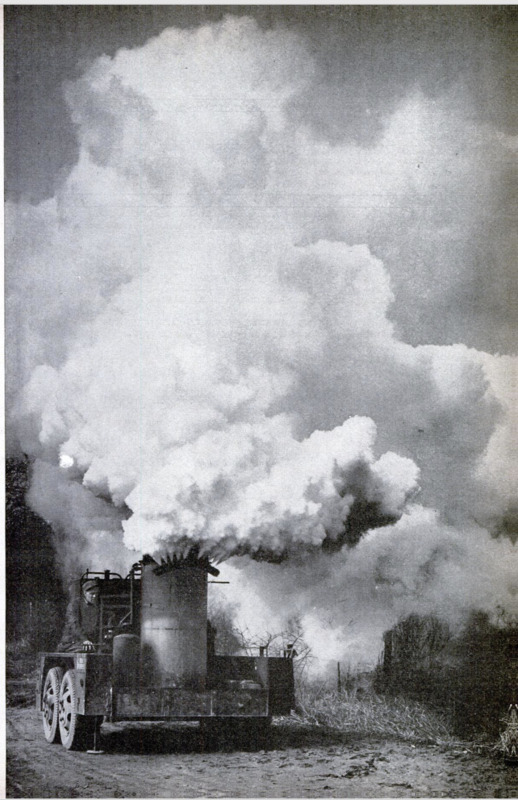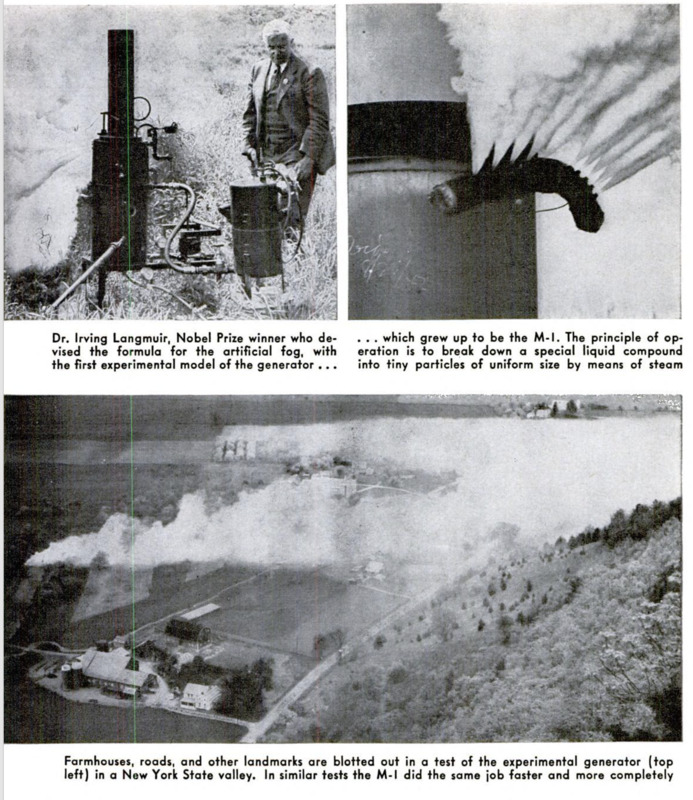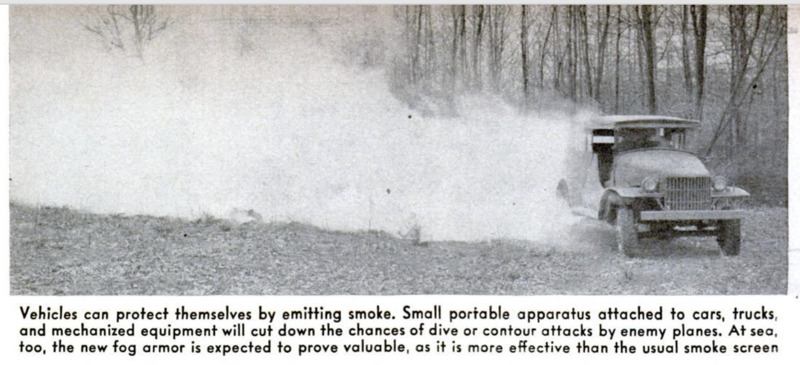-
Titolo
-
Smoke Cover for Land Units Protection
-
Article Title and/or Image Caption
-
"Smoke" Armor. The army finds a magical way to hide troops, ships, factories and even cities in chemical haze made from a formula by Dr. Irving Langmuir
-
extracted text
-
Plazes bombing by daylight, such as
American Army fiyers are doing with
deadly effectiveness in Europe, is absolutely
impossible for enemy airmen on at least nine
days out of ten in several of the most vital
defense areas of the United States. No bomb-
sight can pierce the vast artificial fog which
our Army's mew M-1 smoke generator
throws out as a screening blanket over mili-
tary objectives.
An armor of artificial haze or fog has so
proved its effectiveness in North Africa that
one German bomber pilot was heard com-
plaining by radio in mid-air to another that
he couldn't find his target “because of that
damned smoke.” On the field of combat
large-area smoke screening has made dive
bombing or torpedo bombing absolutely im-
possible where used over concentrations of
men or ships.
The use of smoke to blind an enemy in
warfare is an old story. But the Army's
M-1 mechanical smoke generator is some-
thing so new that several key principles
basic to its successful performance still are
military secrets. It may be told, however,
that with a few of our latest generators a
few hundred men or women operatives can
absolutely blot out areas as large as any of
America’s strategic canals, navy yards, air-
plane factories, or other military supply cen-
ters from the view of enemy airmen, on al-
most any day or night in which flying is
possible.
What nobody can see, nobody can bomb
with precision. The R.A.F. found that out
when trying to destroy the cruisers Scharn-
Horst and Gneisenau in the harbor at Brest.
For many a day British airmen dropped
their missiles hopefully toward these valu-
able targets. Those cruisers escaped. One
reason they got away was the Germans’ use
of a protective smoke screen all around them
—a screen now antiquated as compared with
America’s latest invention for the purpose.
Before Pearl Harbor, the Army set out to
improve American smoke-production meth-
ods as swiftly as possible. Smoke generators
now growing obsolete were already in use
for the screening of limited areas, but what
the Army Service Forces wanted was a de-
vice for screening many square miles, if
necessary.
One of the. most widely used methods for
production of smoke screens at that time
was the partial burning and distillation of
low-grade fuel oils in generators similar to
the orchard heaters and smudge pots used
in California fruit groves.
These oil smoke pots—the best we had—
produced a dark-gray smoke which was ef
fective in obscuring small areas, but their
use was expensive in men and material. The
smoke pots had to be serviced frequently,
almost every hour through the nighttime,
when they were used. They required many
men for operation, and provided little or no
protection if used during the daytime. The
smoke emitted was irritating to the noses
and throats of people in regions protected.
It stained their clothes and hampered their
work.
The job of developing and providing smoke
chemicals and devices is entrusted to the
Chemical Warfare Service under the Army
Service Forces.
No method of smoke projection existed
capable of the large-area daytime screening
which this Service sought. The problem of
finding one was put up to the National De-
fense Research Committee, headed by Presi-
dent James B. Conant of Harvard. This is
the committee, established in 1940, which
has enlisted about 6,000 scientists in 100
schools and 200 industrial laboratories for
war research service, and which in Januar,
1943, was wrestling with about 1,400 re-
search jobs for American armed forces.
One of these scientists is the Nobel Prize
winner, Dr. Irving Langmuir, physicist at
the General Electric Company's research
laboratories, Schenectady, N. Y. Dr. Lang-
muir was one of the men asked by the
National Defense Research Committee to
seek the better smoke formula,
At the moment, Dr. Langmuir and an as-
sistant, Vincent Schaefer, were knee-deep in
a study dealing
with gas masks. Research into screening
smokes fitted into their thought and experi-
mentation. Dr. Langmuir approached the
problem of a smoke screen from the purely
scientific viewpoint of obscuring physical
objects by obstructing or diverting all rays
of light by which they could be seen.
He concluded that the effectiveness of any
smoke must depend on the size, density, and
color of the smoke particles. He concen-
trated on the ideal particle size. Having ar-
rived in his mind at that ideal size, he
turned the job of producing it over to his
assistant, Mr. Schaefer, who built a big
“smoke box” on an upper floor of the Gen-
eral Electric Laboratory. Soon from that
upper floor there poured out such smoke
that once the factory fire department came
rushing to the scene to douse a nonexistent
blaze.
Schaefer made five model devices before
he found one which apparently turned out
the proper smoke particle, a liquid globule
of microscopic proportions. He could mount
to the top of his smoke box after creation of
a smoke screen within it, and look down up-
on that layer of cloud as an airman today
looks down on the screens that are set up
over American military targets by special
smoke companies of the Chemical Warfare
Service. He tested its obscuring power
against various colors and shapes, with
screens of varying thicknesses and heights.
Then the National Defense Research Com-
mittee brought in the Standard Oil Develop-
ment Company's industrial production en-
gineers to build a model unit for producing
the Langmuir-Schaefer type of smoke screen
in quantity. These engineers designed and
produced within a month the first smoke-
generator unit, working on the job of break-
ing down a special liquid compound into
tiny particles of uniform size by use of
steam.
The unit produced was an odd-looking con-
traption—as most of its successors are to-
day, although new designs are now being
made. On the back of the M-1 generator are
three cubicle tanks, joined together to look
like one big box. These carry sufficient
smoke materials for long-time operation. In
the middle of the contraption is a small
gasoline motor, and at the front is a big
cylindrical boiler, with a number of little
vents on a horizontal pipe through which the
smoke clouds are ejected. The whole thing
looks a little like one of those horse-drawn
fire engines of the gay nineties, once it is
‘mounted, as it always is for mobility, upon
a four-wheel trailer. 1t is just a machine for
driving heated smoke compounds through
spray nozzles.
Its designers called the first unit “Junior,”
in affectionate irony, to distinguish it from
some other experimental smoke generators,
then in the making. “Junior” was a military
code word that now has lost all military
significance.
On June 2, 1942, they trundled Junior up
into the Schoharie Valley, a few miles away
from the General Electric plant at Schenec-
tady. On a cloudless, sunny morning, with
only a light wind blowing, the producing
scientists, industrial engineers, a collection
of Army and Navy officers, and some repre-
sentatives of the Canadian National Defense
Research Council went out to see the ma-
chine in action. The onlookers climbed to
the top of a steep cliff, about 600 feet high,
from which they looked down at some miles
of rolling farmlands and surrounding hills.
First they saw a few smokes emitted by
some other generators. These were not im-
pressive. Then “Junior” went to work. From
his one big boiler there came rolling out a
white mist which blotted from view several
miles of the valley within a few minutes.
Close to “Junior's” ten-lipped mouth this
haze was a billowing, swirling smoke cloud
—the kind of dense rolling smoke one might
see in the burning of a great pile of autumn
leaves, only whiter. As it spread out, how-
ever, it was the kind of fog one may see
hanging low over swamps on misty morn-
ings, obscuring all vegetation and wildlife.
Everybody who saw it knew they had
what they were after. If one such contrap-
tion could blot out miles of field and high-
way, and render invisible all distinguishing
marks of the countryside such as groves and
farmhouses, a few dozen could blot out cities.
The machine was taken to Edgewood
Arsenal, that center near Baltimore, Md,
where the Chemical Warfare Service manu-
factures much of the nation’s chemical
warfare equipment. It was tested again.
Officers found that they could walk through
the clouds of billowing fog without the dis-
comfort that came from the old smoke pots.
The haze that encircled them did not soil
their clothing. It was an atmosphere in
which they could continue to work. That
artificial fog had an amazingly high per-
sistency. In succeeding tests it was found
to hang together for as much as 20 miles
downwind, and to obscure all land for at
least half the distance.
Contracts were let for the manufacture of
these M-1 generators. As the machines
rolled from the production lines, they were
used in amphibious training operations on
Cape Cod, Mass. Their white mist quite
blanketed a shore line and stopped traffic on
surrounding roads for miles. A group of the
generators was tried at an Atlantic port
where important naval operations were
under way.
On 10 out of 11 days, this haze not only
hid all outlines of the earth beneath them
from watching flyers, but persons on the
ground in the area of operation found they
could continue their work with little handi-
cap. In November, 1942, when United
States forces made their landings in North
Africa, companies of smoke troops, armed
with these generators which had not been
in existence five months before, proved the
worth of the new device on foreign soil.
Later it was announced that a smoke screen
had been thrown over the Panama Canal as
a test, which effectively obscured that mili-
tary target for many miles.
Today the tactics of large-area smoke
screening are being developed rapidly. Each
area to be obscured has to be treated ac-
cording to local conditions of wind, weather,
and terrain, which vary from day to day.
but which have certain averages. Generators
ordinarily are stationed at selected points to
‘windward of the places to be screened, and
are moved as the wind shifts.
In case of air-raid alarms, smoke blankets
are started from the generators closest to
the most vital points for protection, the dis-
tance depending on how hard the wind is
blowing. A second line of generators then
starts to work some 400 or 500 yards to
windward. As their smoke reaches the vital
point and covers it, the generators originally
closest in will be moved back to positions
still farther to windward.
‘As soon as an unbroken smoke blanket
extends from the outermost generators to
the vital point, such as a factory, power
house, or dock line, the area of the blanket
will be gradually enlarged by moving gen-
erators constantly backward until finally the
‘eginning of the screen may be several miles
from the point which enemy aviators pre-
sumably are seeking.
The generators farthest back from most
vital targets will be located on broken lines,
50 that the smoke or haze does not neces.
sarily appear as artificial to an enemy bomb.
ing pilot, but may produce the illusion of a
Datura phenomenon.
‘Around a harbor, on lakes or rivers, the
generators may be placed on barges when
Decessary to get them upwind, and special
barges have been designed for the purpose.
This obscures shore lines.
It is easy to imagine the difficulty with
which a bombardier is faced when he finds
himself over a target covered with smoke for
‘many square miles. He must either drop his
‘bomb indiscriminately in the smoke with
faint hope that they will damage some im-
portant installation in the area, or he must
find a target that is uncovered in some other
area. That choice is not an easy one.
It a pilot has come several hundred miles
with & mission of bombing a power station
oF an oll refinery and knows that his target
is somewhere within the smoke, he may be
inclined to take a chance and hope that his
bombs will reach their objective. An al-
ternative target which may have been as-
signed may also be screened or it may be
protected by powerful antiaircraft artillery
defenses.
The American theory of bombing lays
great stress on accuracy. Our Air Force
believes our bombardiers can hit a reason-
‘able percentage of their targets. We believe
that point bombing is more profitable than
‘area bombing. Smoke properly placed makes
point bombing impossible.
In the daytime the screen is wide enough
and high enough to cover not only the vital
target, but also most aiming points or land-
marks by which a bombing plane flies
toward its goal. At night a dark-colored
screen not only obscures a target but also
camouflages all ita surrounding region. Gray
smoke, even in the moonlight, has all the
appearance of a body of water when seen
from high altitudes. A pilot or navigator,
‘seeing what looks like a large lake where he
expected to see land, may become confused
as to his position.
“The development of this new machine for
large-area smoke screening, capable of pro-
ducing 50 to 100 times as much smoke with
less cost and less human effort than any pre-
vious smoke apparatus, is one of the major
triumphs of American science in helping to
fight the nation's war.
By the aid of industry. the size of present
smoke generators should soon be cut down,
30 they will be easier to handle and consume
less cargo space when shipped overseas. The
3-1, now the Army's standard, is far heavier
than future machines will be. A model which
is only a small fraction of its size has beer.
developed, and should soon be in production.
Used today exclusively by soldiers, these
generators are so simple to operate and
maintain and require so little heavy labor
that there is no reason why they should not
be operated within the zone of the interior
by limited-service troops or by women. Their
operation by WAACS has been considered,
to release fighting men in some areas for
other duties.
-
Autore secondario
-
Alden H. Waitt (writer)
-
Allen Raymond (writer)
-
Lingua
-
eng
-
Data di rilascio
-
1943-07
-
pagine
-
62-63, 194-196
-
Diritti
-
Public Domain (Google digitized)
-
Archived by
-
Matteo Ridolfi
-
Alberto Bordignon (Supervisor)





